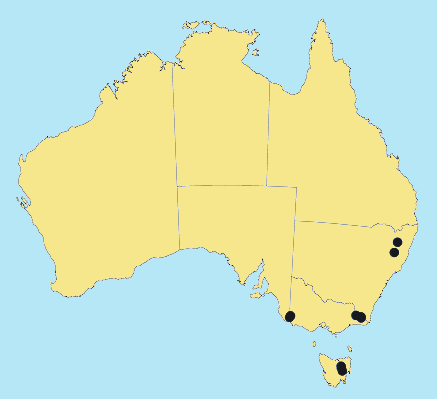Amphibromus sinuatus S.W.L.Jacobs &
Lapinpuro. Telopea 2: 727 (1986).
Classification. (GPWG 2001) : Subfamily Pooideae.
Tribe Poeae.
Type of Basionym or
Protologue Information: Australia: New South Wales: Northern Tablelands:
northern end of Llangothlin Lagoon, c. 4.5 km E of highway, 30.02S 151.46E, Lapinpuro,
Jacobs & Wilson 17 (NSW).
Key references
(books and floras): [2002] D.Sharp & B.K.Simon, AusGrass, Grasses of
Australia, [2006] J.Jessop, G.R.M.Dashorst, F.M.James, Grasses of South
Australia (200), [2008] S.W.L.Jacobs, R.D.B.Walley & D.J.B.Wheeler, Grasses
of New South Wales (119), [2009] A.Wilson (ed.). Flora of Australia,
Vol 44A. Poaceae 2 (136).
Illustrations:
[2002] D.Sharp & B.K.Simon, AusGrass, Grasses of Australiia, [2006]
J.Jessop, G.R.M.Dashorst, F.M.James, Grasses of South Australia (199, fig. 149), [2008] S.W.L.Jacobs,
R.D.B.Whalley & D.J.B.Wheeler, Grasses of New South Wales, 4th edn
(119), [2009]. A.Wilson (ed.), Flora of Australia 44A: Poaceae 2
(135, Fig.20).
Derivation: L. sinus,
curve; -ata, possessing. Lemma apex sinuate.
Habit.
Perennial. Stolons present. Culms geniculately ascending or decumbent, 40–70 cm
tall, 0.8–2 mm diam., 1–4 -noded. Mid-culm nodes glabrous. Leaf-sheaths smooth
or scaberulous. Ligule an eciliate membrane, 5–11 mm long, acute or acuminate.
Leaf-blades 8–17 cm long, 1–4 mm wide. Leaf-blade surface scabrous.
Inflorescence.
Inflorescence compound, a panicle. Panicle 10–21 cm long.
Spikelets.
Spikelets pedicelled. Fertile spikelets many flowered, with at least 2 fertile
florets (5–6), comprising 5–6 fertile floret(s), with a barren rachilla
extension or with diminished florets at the apex, oblong, laterally compressed,
9–21 mm long.
Glumes. Glumes
similar, thinner than fertile lemma. Lower glume lanceolate, membranous,
keeled, 1-keeled, 1–3 -nerved. Upper glume lanceolate, (3.5–)4.3–6 mm long,
membranous, keeled, 1-keeled, 3–5 -nerved.
Florets.
Fertile lemma (4.5–)6.2–8.2 mm long, without keel, 7 -nerved. Lemma apex
dentate, awned, 1 -awned. Median (principal) awn dorsal, 14–26 mm long overall,
with a straight or slightly twisted column or with a twisted column. Lodicules
present. Anthers 3. Grain 2.3–2.7 mm long.
Continental
Distribution: Australasia.
Australian
Distribution: South Australia, New South Wales, Victoria, Tasmania.
South Australia:
South-eastern. New South Wales: Northern Tablelands. Victoria:
East Gippsland, Gippsland Plain, Wannon. Tasmania: Midlands.
Notes. Endemic.
In Tas. restricted to farm dams in the Midlands and the margins of L. Crescent,
Vic. and N.S.W. in cold areas, permanent swamps. Flowers Nov.-Jan.



